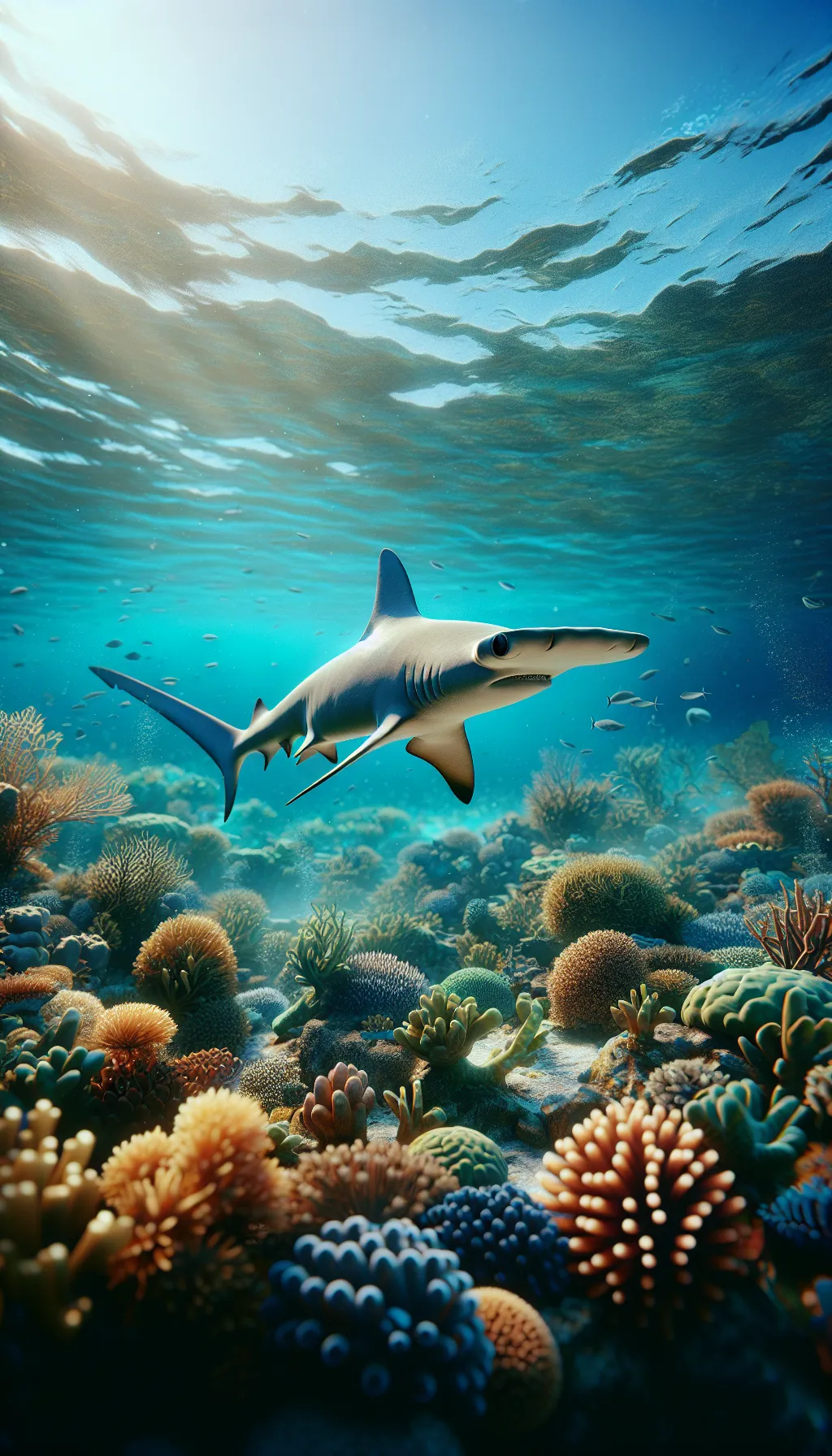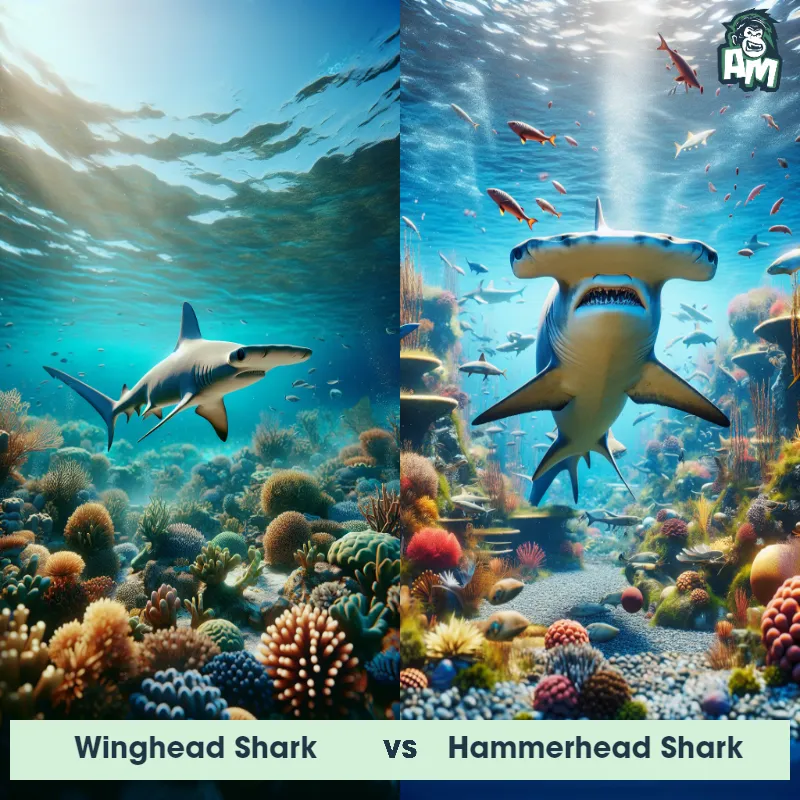The Winghead Shark
The Winghead Shark, also known as Eusphyra blochii, is a distinctive species of shark that belongs to the hammerhead family. It is characterized by its unique head shape, with a pair of long, slender lobes extending laterally from its eyes. These lobes, known as cephalofoil, give it a wingspan-like appearance. The body of the Winghead Shark is slender and streamlined, and it can grow up to 6 feet in length. Its coloration ranges from gray to brown, helping it camouflage in its coastal habitats. This species is primarily found in the Indo-West Pacific region, particularly in shallow waters near coral reefs.

| Winghead Shark | |
|---|---|
| Size | 9.8 feet (3 meters) |
| Weight | Varies |
| Speed | 25mph (40km/h) |
| Key Strength | Agile swimming and maneuverability |
| Biggest Weakness | Vulnerability due to wide head shape |
| Scientific Name | Eusphyra blochii |
| Family | Sphyrnidae |
| Habitat | Coastal waters, estuaries, bays, and coral reefs |
| Geography | Indo-Pacific region |
| Diet | Fish, squid, crustaceans |
| Lifespan | 25 years - 30 years |

The Winghead Shark
The Winghead Shark, also known as Eusphyra blochii, is a distinctive species of shark that belongs to the hammerhead family. It is characterized by its unique head shape, with a pair of long, slender lobes extending laterally from its eyes. These lobes, known as cephalofoil, give it a wingspan-like appearance. The body of the Winghead Shark is slender and streamlined, and it can grow up to 6 feet in length. Its coloration ranges from gray to brown, helping it camouflage in its coastal habitats. This species is primarily found in the Indo-West Pacific region, particularly in shallow waters near coral reefs.
![[object Object] Gif](https://tenor.com/view/close-encounter-can-sharks-detect-magnetic-fields-sixth-sense-sharkcano-hammerhead-shark-gif-19120107.gif)
Fun Fact: The Winghead Shark has the most pronouncedly wing-shaped head among all the hammerhead shark species, hence its common name.
| Winghead Shark | |
|---|---|
| Size | 9.8 feet (3 meters) |
| Weight | Varies |
| Speed | 25mph (40km/h) |
| Key Strength | Agile swimming and maneuverability |
| Biggest Weakness | Vulnerability due to wide head shape |
| Scientific Name | Eusphyra blochii |
| Family | Sphyrnidae |
| Habitat | Coastal waters, estuaries, bays, and coral reefs |
| Geography | Indo-Pacific region |
| Diet | Fish, squid, crustaceans |
| Lifespan | 25 years - 30 years |
Winghead Shark Matchups
We use AI to simulate matchups between the Winghead Shark and other animals. Our simulation considers size, strength, and natural predatory behaviors to determine the most likely outcome.

Can't find the Matchup you want?
Create Your Own MatchupWinghead Shark: Diet, Predators, Aggression, and Defensive Behaviors
What do Winghead Sharks eat?
Winghead Sharks primarily feed on small fish, crustaceans, and cephalopods. They use their unique head shape to maximize maneuverability while hunting for prey in coral reefs and rocky areas.
Do Winghead Sharks have any predators?
As apex predators themselves, Winghead Sharks do not have many natural predators. However, larger sharks such as Tiger Sharks and Great White Sharks may pose a threat to them.
Are Winghead Sharks aggressive?
Winghead Sharks are typically not considered aggressive towards humans unless provoked. They are known to be shy and wary of divers, preferring to keep their distance.
Do Winghead Sharks fight with other species?
Winghead Sharks may engage in territorial disputes or competition for food resources with other shark species. However, they are more likely to resort to displays of dominance rather than physical combat.
How do Winghead Sharks defend themselves?
In defense, Winghead Sharks can use their speed and agility to evade potential threats. They may also rely on their sharp teeth and powerful jaws to intimidate predators or aggressors.
What is the biggest weakness of Winghead Sharks in a fight?
Despite their impressive swimming abilities, Winghead Sharks have relatively small size compared to some other shark species. This can make them vulnerable to larger predators or competitors in aggressive encounters.
Fun Fact: Unlike other shark species, the Winghead Shark has an unusually high number of senses due to its hammer-shaped head, which allows it to detect a wide range of prey, including small fish, crustaceans, and cephalopods.
Fun Fact: The Winghead Shark is known for its relatively large litter size, with females giving birth to approximately 6 to 28 live young. This reproductive strategy helps to ensure the survival and propagation of the species.











